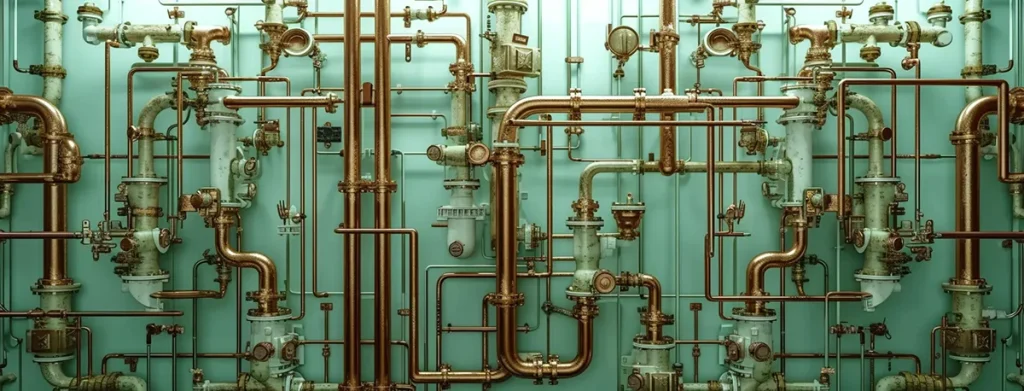Imagine your home’s plumbing system as the veins and arteries of your body, delivering essential water to every room and carrying waste away, much like blood flows through your body. Did you know that the average household in the U.S. uses about 300 gallons of water per day, with about 10% of homes wasting 90 gallons or more due to leaks? Understanding how your home’s plumbing system works is crucial not only for comfort but also for efficiency and cost savings.
Overview of a Typical Plumbing System
A home’s plumbing system consists of three primary components: supply lines, drainpipes, and fixtures.
- Supply Lines: These bring clean water into your home from a municipal source or a private well. They typically include cold water and hot water lines that connect to various fixtures like sinks, showers, and appliances.
- Drainpipes: Once the water has been used, it becomes wastewater, which needs to be safely removed. This is where the drainpipes come into play, carrying waste and used water away from your home to either a septic system or a public sewer.
- Fixtures: Fixtures are the end points where water is accessed, such as faucets, showerheads, toilets, and dishwashers. They are designed to control the flow of water and are connected to both the supply and drainage systems.
How Water Flows Through Your Home’s Plumbing System
Water enters your home through a main supply line that is typically located near the foundation or basement. From there, it is distributed to various parts of the house through a network of pipes. The journey of water includes:
- Entering the home: The main supply line brings water into the home, which is then directed to a water meter (if connected to a municipal supply) to measure usage.
- Heating the water: Cold water is routed to your water heater, where it is warmed and then supplied to fixtures that require hot water.
- Distributing the water: Water flows through supply pipes to fixtures and appliances. The pressure in the pipes ensures water is available when you turn on a tap or run an appliance.
- Draining away: Used water and waste are directed through the drainpipes, leading to either a septic system or the public sewer.
Key Components and Their Functions
- Water Heater: This appliance heats the water for your home. It’s available in electric, gas, or tankless models. The heater stores hot water and delivers it as needed.
- Shut-Off Valves: These are crucial for controlling the water supply to different parts of the home. In an emergency, like a burst pipe, knowing the location of your main shut-off valve can prevent significant damage.
- Traps: These are curved sections of pipes under sinks that prevent sewer gases from entering your home. They trap a small amount of water, which acts as a barrier.
Common Plumbing Materials: Advantages and Disadvantages
- Copper: Long-lasting and durable, copper pipes resist corrosion but can be expensive and difficult to install.
- PEX (Cross-linked Polyethylene): Flexible, easy to install, and resistant to freezing, PEX is a popular choice in modern plumbing but can be sensitive to UV light.
- PVC (Polyvinyl Chloride): Used mainly for drainpipes, PVC is lightweight and easy to work with, though it can become brittle over time.
- Galvanized Steel: Once common in older homes, these pipes are durable but prone to corrosion and buildup, leading to reduced water flow.
Identifying and Addressing Potential Plumbing Issues
- Leaky Faucets: A common issue that often results from a worn-out washer or seal. Replace the faulty part to stop the drip.
- Slow Drains: Often caused by a buildup of debris. Use a plunger or a drain snake to clear the obstruction.
- Low Water Pressure: This could be due to mineral buildup in the pipes or an issue with the municipal water supply. Cleaning aerators or checking for leaks can help restore pressure.
- Running Toilets: Usually caused by a faulty flapper valve. Replacing the valve typically resolves the issue.
Regular Maintenance Tips For Your Home’s Plumbing System
- Inspect for Leaks: Regularly check under sinks, around toilets, and near appliances for signs of water leakage.
- Clean Aerators: Mineral deposits can clog aerators on faucets, reducing water pressure. Clean them regularly to maintain flow.
- Flush Water Heater: To prevent sediment buildup, flush your water heater once a year.
- Check Shut-Off Valves: Test the main and fixture-specific shut-off valves annually to ensure they’re functioning properly.
- Inspect Hoses: Check washing machine and dishwasher hoses for signs of wear and replace them every few years to prevent leaks.
Regional and Home Type Considerations
- Older Homes: May have outdated materials like galvanized steel, which are prone to corrosion. Upgrading to copper or PEX can improve efficiency.
- Newer Homes: Typically have modern materials like PEX or CPVC, which are durable and less likely to corrode.
- Regional Variations: In areas with cold climates, pipes need to be insulated to prevent freezing. Homes in warmer regions may not require as much insulation but should focus on water conservation measures.
Conclusion
Understanding your home’s plumbing system empowers you to address minor issues before they become major problems and ensures that your system operates efficiently. Regular maintenance, combined with knowledge of how your plumbing works, can extend the life of your home’s plumbing system and save you money on repairs. Always consult a professional for complex issues or if you’re unsure about any aspect of your plumbing.
For more tips on maintaining your plumbing system, or if you need expert help with a plumbing issue, don’t hesitate to reach out to a licensed plumber in your area. Regular check-ups can keep your system running smoothly and prevent costly repairs down the line.



